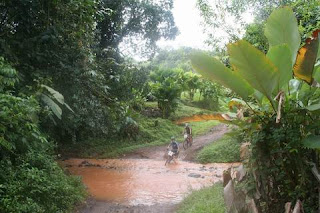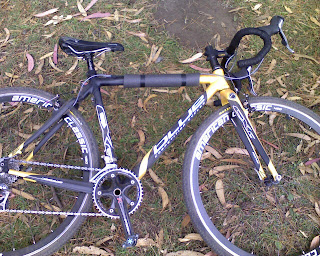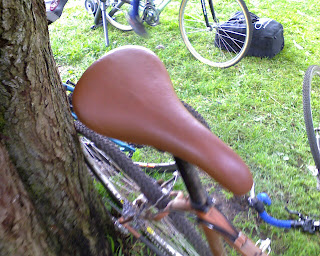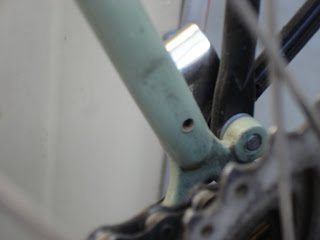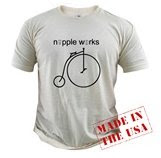My legs are still tired from this year's Kennedy Trail Turkey Ride. I didn't know about it until this week, but apparently every year, people ride their bikes up the very steep Kennedy Trail in Los Gatos, CA and bring Thanksgiving treats to eat and drink at the top. I have ridden and hiked this fire road several times in the past, but never with the kind of crowds that turned out today. The climb is probably a solid 2000 vertical feet. It starts bright and early, so if you do it, you might also make it over the river and through the woods to Grandmother's house for an evening supper. Things to bring, besides food and drink, include an extra layer for the ride down and a bell for your handlebars to signal hikers and bikers on your descent.
 All sorts of fun, wacky bikes show up at the starting point in downtown Los Gatos. This Retrotec model was recently acquired by its owner (although it looks rather vintage) and the stiffness of the rear 'triangle' is adjustable by tensioning the cables/rods that go from the seat tube to the rear dropouts.
All sorts of fun, wacky bikes show up at the starting point in downtown Los Gatos. This Retrotec model was recently acquired by its owner (although it looks rather vintage) and the stiffness of the rear 'triangle' is adjustable by tensioning the cables/rods that go from the seat tube to the rear dropouts. More weird wild bikes include this leopard print tandem with moto style upside down forks. A tandem would be fun for this ride since you enjoy the added power of two riders on 1.5 bikes and the downhill is not very technical.
More weird wild bikes include this leopard print tandem with moto style upside down forks. A tandem would be fun for this ride since you enjoy the added power of two riders on 1.5 bikes and the downhill is not very technical. The leopard tandem also had a festive gecko idler gear just sort of floating in the timing chain between the pilot and stoker.
The leopard tandem also had a festive gecko idler gear just sort of floating in the timing chain between the pilot and stoker. This "Yokota Project USA" tandem was built at the dawn of mountain bike suspension. The "Shock Blades" fork offered about 18mm of travel (unless it was locked down in some way) and the bike made use of elastomer shock stems for both riders. Put a rack on this thing and you have a mean turkey toting machine.
This "Yokota Project USA" tandem was built at the dawn of mountain bike suspension. The "Shock Blades" fork offered about 18mm of travel (unless it was locked down in some way) and the bike made use of elastomer shock stems for both riders. Put a rack on this thing and you have a mean turkey toting machine.
 It wasn't all contraptions and tandems. A few riders showed up on cross bikes, lots of people pushed excessively suspended downhill bikes up the trail, and one guy rode his very fancy LOOK carbon fiber race machine.
It wasn't all contraptions and tandems. A few riders showed up on cross bikes, lots of people pushed excessively suspended downhill bikes up the trail, and one guy rode his very fancy LOOK carbon fiber race machine.Happy Thanksgiving to everyone from nippleworks.



